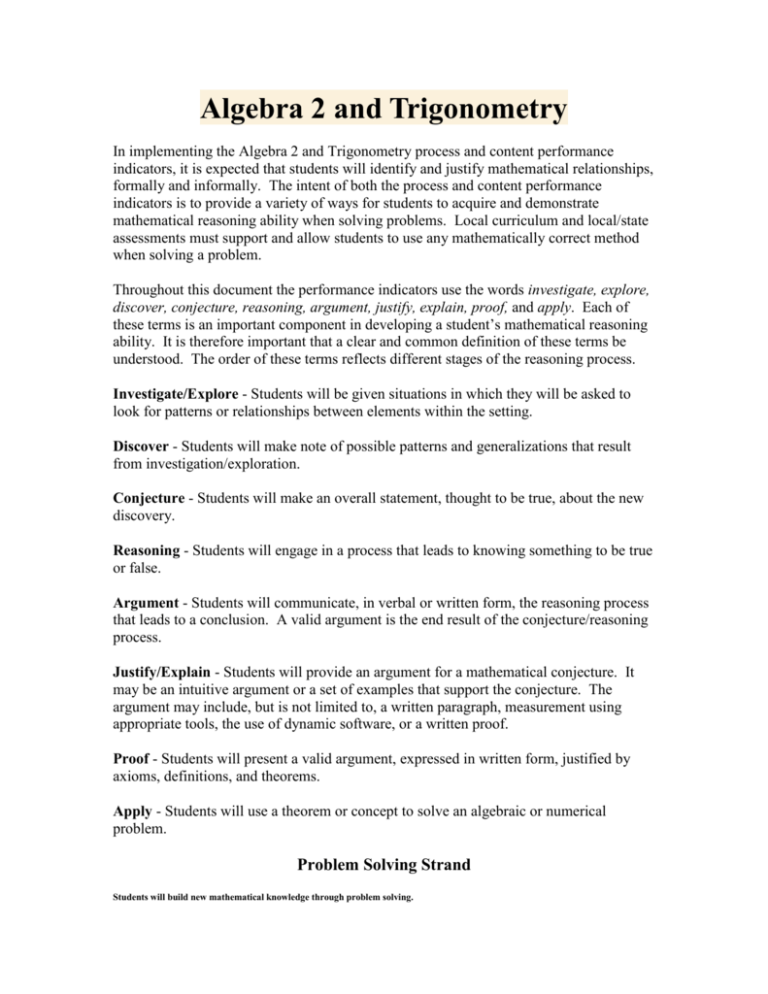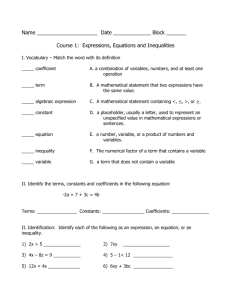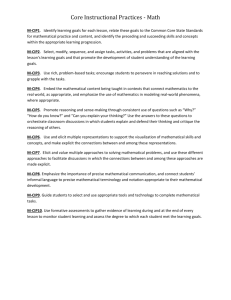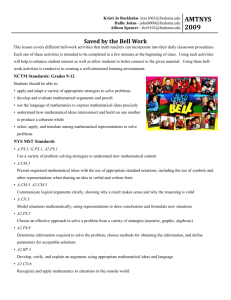Algebra 2 and Trigonometry
advertisement

Algebra 2 and Trigonometry In implementing the Algebra 2 and Trigonometry process and content performance indicators, it is expected that students will identify and justify mathematical relationships, formally and informally. The intent of both the process and content performance indicators is to provide a variety of ways for students to acquire and demonstrate mathematical reasoning ability when solving problems. Local curriculum and local/state assessments must support and allow students to use any mathematically correct method when solving a problem. Throughout this document the performance indicators use the words investigate, explore, discover, conjecture, reasoning, argument, justify, explain, proof, and apply. Each of these terms is an important component in developing a student’s mathematical reasoning ability. It is therefore important that a clear and common definition of these terms be understood. The order of these terms reflects different stages of the reasoning process. Investigate/Explore - Students will be given situations in which they will be asked to look for patterns or relationships between elements within the setting. Discover - Students will make note of possible patterns and generalizations that result from investigation/exploration. Conjecture - Students will make an overall statement, thought to be true, about the new discovery. Reasoning - Students will engage in a process that leads to knowing something to be true or false. Argument - Students will communicate, in verbal or written form, the reasoning process that leads to a conclusion. A valid argument is the end result of the conjecture/reasoning process. Justify/Explain - Students will provide an argument for a mathematical conjecture. It may be an intuitive argument or a set of examples that support the conjecture. The argument may include, but is not limited to, a written paragraph, measurement using appropriate tools, the use of dynamic software, or a written proof. Proof - Students will present a valid argument, expressed in written form, justified by axioms, definitions, and theorems. Apply - Students will use a theorem or concept to solve an algebraic or numerical problem. Problem Solving Strand Students will build new mathematical knowledge through problem solving. A2.PS.1 Use a variety of problem solving strategies to understand new mathematical content A2.PS.2 Recognize and understand equivalent representations of a problem situation or a mathematical concept Students will solve problems that arise in mathematics and in other contexts. A2.PS.3 Observe and explain patterns to formulate generalizations and conjectures A2.PS.4 Use multiple representations to represent and explain problem situations (e.g., verbally, numerically, algebraically, graphically) Students will apply and adapt a variety of appropriate strategies to solve problems. A2.PS.5 Choose an effective approach to solve a problem from a variety of strategies (numeric, graphic, algebraic) A2.PS.6 Use a variety of strategies to extend solution methods to other problems A2.PS.7 Work in collaboration with others to propose, critique, evaluate, and value alternative approaches to problem solving Students will monitor and reflect on the process of mathematical problem solving. A2.PS.8 Determine information required to solve a problem, choose methods for obtaining the information, and define parameters for acceptable solutions A2.PS.9 Interpret solutions within the given constraints of a problem A2.PS.10 Evaluate the relative efficiency of different representations and solution methods of a problem Reasoning and Proof Strand Students will recognize reasoning and proof as fundamental aspects of mathematics. A2.RP.1 Support mathematical ideas using a variety of strategies Students will make and investigate mathematical conjectures. A2.RP.2 Investigate and evaluate conjectures in mathematical terms, using mathematical strategies to reach a conclusion A2.RP.3 Evaluate conjectures and recognize when an estimate or approximation is more appropriate than an exact answer A2.RP.4 Recognize when an approximation is more appropriate than an exact answer Students will develop and evaluate mathematical arguments and proofs. A2.RP.5 Develop, verify, and explain an argument, using appropriate mathematical ideas and language A2.RP.6 Construct logical arguments that verify claims or counterexamples that refute them A2.RP.7 Present correct mathematical arguments in a variety of forms A2.RP.8 Evaluate written arguments for validity Students will select and use various types of reasoning and methods of proof. A2.RP.9 Support an argument by using a systematic approach to test more than one case A2.RP.10 Devise ways to verify results, using counterexamples and informal indirect proof A2.RP.11 Extend specific results to more general cases A2.RP.12 Apply inductive reasoning in making and supporting mathematical conjectures Communication Strand Students will organize and consolidate their mathematical thinking through communication. A2.CM.1 Communicate verbally and in writing a correct, complete, coherent,and clear design (outline) and explanation for the steps used in solving a problem A2.CM.2 Use mathematical representations to communicate with appropriate accuracy, including numerical tables, formulas, functions, equations, charts, graphs, and diagrams Students will communicate their mathematical thinking coherently and clearly to peers, teachers, and others. A2.CM.3 Present organized mathematical ideas with the use of appropriate standard notations, including the use of symbols and other representations when sharing an idea in verbal and written form A2.CM.4 Explain relationships among different representations of a problem A2.CM.5 Communicate logical arguments clearly, showing why a result makes sense and why the reasoning is valid A2.CM.6 Support or reject arguments or questions raised by others about the correctness of mathematical work Students will analyze and evaluate the mathematical thinking and strategies of others. A2.CM.7 Read and listen for logical understanding of mathematical thinking shared by other students A2.CM.8 Reflect on strategies of others in relation to one’s own strategy A2.CM.9 Formulate mathematical questions that elicit, extend, or challenge strategies, solutions, and/or conjectures of others Students will use the language of mathematics to express mathematical ideas precisely. A2.CM.10 Use correct mathematical language in developing mathematical questions that elicit, extend, or challenge other students’ conjectures A2.CM.11 Represent word problems using standard mathematical notation A2.CM.12 Understand and use appropriate language, representations, and terminology when describing objects, relationships, mathematical solutions, and rationale A2.CM.13 Draw conclusions about mathematical ideas through decoding, comprehension, and interpretation of mathematical visuals, symbols, and technical writing Connections Strand Students will recognize and use connections among mathematical ideas. A2.CN.1 Understand and make connections among multiple representations of the same mathematical idea A2.CN.2 Understand the corresponding procedures for similar problems or mathematical concepts Students will understand how mathematical ideas interconnect and build on one another to produce a coherent whole. A2.CN.3 Model situations mathematically, using representations to draw conclusions and formulate new situations A2.CN.4 Understand how concepts, procedures, and mathematical results in one area of mathematics can be used to solve problems in other areas of mathematics A2.CN.5 Understand how quantitative models connect to various physical models and representations Students will recognize and apply mathematics in contexts outside of mathematics. A2.CN.6 Recognize and apply mathematics to situations in the outside world A2.CN.7 Recognize and apply mathematical ideas to problem situations that develop outside of mathematics A2.CN.8 Develop an appreciation for the historical development of mathematics Representation Strand Students will create and use representations to organize, record, and communicate mathematical ideas. A2.R.1 A2.R.2 A2.R.3 Use physical objects, diagrams, charts, tables, graphs, symbols, equations, or objects created using technology as representations of mathematical concepts Recognize, compare, and use an array of representational forms Use representation as a tool for exploring and understanding mathematical ideas Students will select, apply, and translate among mathematical representations to solve problems. A2.R.4 A2.R.5 Select appropriate representations to solve problem situations Investigate relationships between different representations and their impact on a given problem Students will use representations to model and interpret physical, social, and mathematical phenomena. A2.R.6 A2.R.7 A2.R.8 Use mathematics to show and understand physical phenomena (e.g., investigate sound waves using the sine and cosine functions) Use mathematics to show and understand social phenomena (e.g., interpret the results of an opinion poll) Use mathematics to show and understand mathematical phenomena (e.g., use random number generator to simulate a coin toss) Number Sense and Operations Strand Students will understand meanings of operations and procedures, and how they relate to one another. Operations A2.N.1 Evaluate numerical expressions with negative and/or fractional exponents, without the aid of a calculator (when the answers are rational numbers) A2.N.2 Perform arithmetic operations (addition, subtraction, multiplication, division) with expressions containing irrational numbers in radical form A2.N.3 Perform arithmetic operations with polynomial expressions containing rational coefficients A2.N.4 Perform arithmetic operations on irrational expressions A2.N.5 Rationalize a denominator containing a radical expression A2.N.6 Write square roots of negative numbers in terms of i A2.N.7 Simplify powers of i A2.N.8 Determine the conjugate of a complex number A2.N.9 Perform arithmetic operations on complex numbers and write the answer in the form Note: This includes simplifying expressions with complex denominators. A2.N.10 Know and apply sigma notation Algebra Strand Students will represent and analyze algebraically a wide variety of problem solving situations. Equations and Inequalities A2.A.1 Solve absolute value equations and inequalities involving linear expressions in one variable A2.A.2 Use the discriminant to determine the nature of the roots of a quadratic equation A2.A.3 Solve systems of equations involving one linear equation and one quadratic equation algebraically Note: This includes rational equations that result in linear equations with extraneous roots. A2.A.4 Solve quadratic inequalities in one and two variables, algebraically and graphically A2.A.5 Use direct and inverse variation to solve for unknown values A2.A.6 Solve an application which results in an exponential function Students will perform algebraic procedures accurately. Variables and Expressions A2.A.7 A2.A.8 A2.A.9 A2.A.10 A2.A.11 A2.A.12 A2.A.13 A2.A.14 A2.A.15 A2.A.16 A2.A.17 A2.A.18 A2.A.19 Factor polynomial expressions completely, using any combination of the following techniques: common factor extraction, difference of two perfect squares, quadratic trinomials Apply the rules of exponents to simplify expressions involving negative and/or fractional exponents Rewrite algebraic expressions that contain negative exponents using only positive exponents Rewrite algebraic expressions with fractional exponents as radical expressions Rewrite algebraic expressions in radical form as expressions with fractional exponents Evaluate exponential expressions, including those with base e Simplify radical expressions Perform addition, subtraction, multiplication, and division of radical expressions Rationalize denominators involving algebraic radical expressions Perform arithmetic operations with rational expressions and rename to lowest terms Simplify complex fractional expressions Evaluate logarithmic expressions in any base Apply the properties of logarithms to rewrite logarithmic expressions in equivalent forms Equations and Inequalities A2.A.20 Determine the sum and product of the roots of a quadratic equation by examining its coefficients A2.A.21 Determine the quadratic equation, given the sum and product of its roots A2.A.22 Solve radical equations A2.A.23 Solve rational equations and inequalities A2.A.24 Know and apply the technique of completing the square A2.A.25 Solve quadratic equations, using the quadratic formula A2.A.26 Find the solution to polynomial equations of higher degree that can be solved using factoring and/or the quadratic formula A2.A.27 Solve exponential equations with and without common bases A2.A.28 Solve a logarithmic equation by rewriting as an exponential equation Students will recognize, use, and represent algebraically patterns, relations, and functions. Patterns, Relations, and Functions A2.A.29 Identify an arithmetic or geometric sequence and find the formula for its nth term A2.A.30 Determine the common difference in an arithmetic sequence A2.A.31 Determine the common ratio in a geometric sequence A2.A.32 Determine a specified term of an arithmetic or geometric sequence A2.A.33 Specify terms of a sequence, given its recursive definition A2.A.34 Represent the sum of a series, using sigma notation A2.A.35 Determine the sum of the first n terms of an arithmetic or geometric series A2.A.36 Apply the binomial theorem to expand a binomial and determine a specific term of a binomial expansion A2.A.37 Define a relation and function A2.A.38 Determine when a relation is a function A2.A.39 Determine the domain and range of a function from its equation A2.A.40 Write functions in functional notation A2.A.41 Use functional notation to evaluate functions for given values in the domain A2.A.42 Find the composition of functions A2.A.43 Determine if a function is one-to-one, onto, or both A2.A.44 Define the inverse of a function A2.A.45 Determine the inverse of a function and use composition to justify the result A2.A.46 Perform transformations with functions and relations: , , , , Coordinate Geometry A2.A.47 Determine the center-radius form for the equation of a circle in standard form A2.A.48 Write the equation of a circle, given its center and a point on the circle A2.A.49 Write the equation of a circle from its graph A2.A.50 Approximate the solution to polynomial equations of higher degree by inspecting the graph A2.A.51 Determine the domain and range of a function from its graph A2.A.52 Identify relations and functions, using graphs A2.A.53 Graph exponential functions of the form for positive values of b, including A2.A.54 Graph logarithmic functions, using the inverse of the related exponential function Trigonometric Functions A2.A.55 Express and apply the six trigonometric functions as ratios of the sides of a right triangle A2.A.56 Know the exact and approximate values of the sine, cosine, and tangent of 0º, 30º, 45º, 60º, 90º, 180º, and 270º angles A2.A.57 Sketch and use the reference angle for angles in standard position A2.A.58 Know and apply the co-function and reciprocal relationships between trigonometric ratios A2.A.59 Use the reciprocal and co-function relationships to find the value of the secant, cosecant, and cotangent of 0º, 30º, 45º, 60º, 90º, 180º, and 270º angles A2.A.60 Sketch the unit circle and represent angles in standard position A2.A.61 Determine the length of an arc of a circle, given its radius and the measure of its central angle A2.A.62 Find the value of trigonometric functions, if given a point on the terminal side of angle A2.A.63 Restrict the domain of the sine, cosine, and tangent functions to ensure the existence of an inverse function A2.A.64 Use inverse functions to find the measure of an angle, given its sine, cosine, or tangent A2.A.65 Sketch the graph of the inverses of the sine, cosine, and tangent functions A2.A.66 Determine the trigonometric functions of any angle, using technology A2.A.67 Justify the Pythagorean identities A2.A.68 Solve trigonometric equations for all values of the variable from 0º to 360º A2.A.69 Determine amplitude, period, frequency, and phase shift, given the graph or equation of a periodic function A2.A.70 Sketch and recognize one cycle of a function of the form A2.A.71 A2.A.72 A2.A.73 A2.A.74 A2.A.75 A2.A.76 A2.A.77 or Sketch and recognize the graphs of the functions , , , and Write the trigonometric function that is represented by a given periodic graph Solve for an unknown side or angle, using the Law of Sines or the Law of Cosines Determine the area of a triangle or a parallelogram, given the measure of two sides and the included angle Determine the solution(s) from the SSA situation (ambiguous case) Apply the angle sum and difference formulas for trigonometric functions Apply the double-angle and half-angle formulas for trigonometric functions Measurement Strand Students will determine what can be measured and how, using appropriate methods and formulas. Units of Measurement A2.M.1 A2.M.2 Define radian measure Convert between radian and degree measures Statistics and Probability Strand Students will collect, organize, display, and analyze data. Collection of Data A2.S.1 A2.S.2 Understand the differences among various kinds of studies (e.g., survey, observation, controlled experiment) Determine factors which may affect the outcome of a survey Students will collect, organize, display, and analyze data. Organization and Display of Data A2.S.3 A2.S.4 Calculate measures of central tendency with group frequency distributions Calculate measures of dispersion (range, quartiles, interquartile range, standard deviation, variance) for both A2.S.5 samples and populations Know and apply the characteristics of the normal distribution Students will make predictions that are based upon data analysis. Predictions from Data A2.S.6 A2.S.7 A2.S.8 Determine from a scatter plot whether a linear, logarithmic, exponential, or power regression model is most appropriate Determine the function for the regression model, using appropriate technology, and use the regression function to interpolate and extrapolate from the data Interpret within the linear regression model the value of the correlation coefficient as a measure of the strength of the relationship Students will understand and apply concepts of probability. Probability A2.S.9 A2.S.10 A2.S.11 A2.S.12 A2.S.13 A2.S.14 A2.S.15 A2.S.16 Differentiate between situations requiring permutations and those requiring combinations Calculate the number of possible permutations of n items taken r at a time Calculate the number of possible combinations of n items taken r at a time Use permutations, combinations, and the Fundamental Principle of Counting to determine the number of elements in a sample space and a specific subset (event) Calculate theoretical probabilities, including geometric applications Calculate empirical probabilities Know and apply the binomial probability formula to events involving the terms exactly, at least, and at most Use the normal distribution as an approximation for binomial probabilities







